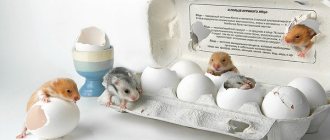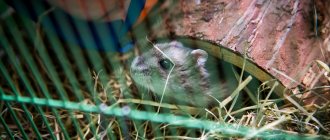These small, furry rodents are one of the most popular pets.
flickr/pyza
Hamsters have won a strong place in the homes and hearts of caring owners thanks to their unpretentiousness, friendliness and intelligence. But despite all their advantages and popularity, the decision to place a new furry pet in your home must be approached with all responsibility.
To buy or not to buy?
The first thing you need to pay attention to is that family members are not allergic to animal hair or bedding fillers. Second, but no less important, is the choice of location for the cage of the future pet. Hamsters equally do not like drafts, too warm or cold air, and dampness. They do not belong in a smoky room, on the floor or windowsill. It is important to remember that these are living beings and they have the right to demand that they be treated with dignity.
flickr/pyza
Other indisputable advantages of keeping hamsters include their low cost and ease of care, which does not require special skills. The small amount of food a hamster needs for a full life will not affect the family budget in any way, and its cage will not take up much space in the apartment.
Pros and cons of content
Pros of keeping a hamster
- low cost of a hamster;
- low cost of accessories for maintenance;
- takes up little space;
- does not require special care and knowledge;
- does not make noise;
- no wool;
- no need for daily walks;
- you can keep one hamster, without a pair;
- does not pose a danger to both adults and children;
- easy to breed;
- easy to place the babies.
Disadvantages of keeping a hamster
- they sleep during the day and are active at night;
- unpleasant odor if you do not clean up food debris and excrement daily;
- low life expectancy, from 2 to 3 years;
- some individuals hibernate, depending on the species and conditions of detention.
Cell selection
A cage with vertical or horizontal bars is the most suitable and comfortable home for a hamster. Its size depends on the breed of hamster. For dwarf hamsters - Djungarian and Roborovsky - the height and width are approximately 30 cm, length - 50 cm. For golden or Syrian hamsters, it is better to choose a larger cage - 40 cm wide and high, about 60 cm long.
Unlike Syrian hamsters, Djungarian and Roborovian hamsters are indifferent to climbing rods and other acrobatic tricks, so plastic cages (dunes) are quite suitable for them. Under no circumstances should hamsters be placed in tall and narrow aquariums - bacteria multiply very quickly here, there is high humidity and there is almost no access to fresh air.
flickr/pyza
What is required for maintenance
Proper keeping of a hamster at home can not only improve the well-being and health of the small rodent, but also prolong its life. If you create all the conditions for a comfortable existence, the hamster will live a long and happy life without stress.
To keep a pet hamster you need:
- cell;
- house;
- toys;
- feeders 2 pieces;
- drinking bowl;
- running wheel, ball, maze, playground or tunnel.
When choosing a cage, you need to take into account the number and type of hamsters you plan to keep. It is not recommended to house several hamsters in one cage, but in practice it turns out differently. The minimum cage size for one rodent is 60 by 40 cm. It is important that the bars of the cage are positioned horizontally, since hamsters are very active and love to climb the walls of the cage.
The cage must be selected specifically for small rodents. Since the distance between the rods plays an important role. If you are planning to get dwarf hamsters, choose a distance so that a small hamster cannot fit between them.
To keep hamsters, they often buy a cage. But you can use an aquarium. It is important that the size of the aquarium also corresponds to the minimum size of 60 by 40 cm per pet, and the number of hamsters living.
Under no circumstances should hamsters be kept in cardboard boxes or plastic containers. Hamsters are rodents; their teeth grow throughout their lives. They will instantly chew up a dwelling made of fragile material and run away. Finding and catching an escaped hamster is not an easy task. But besides this, he can also get poisoned.
Cage interior
To make your pet feel happy and healthy, he needs to not only be fed, but also entertained. Golden hamsters cannot do without climbing devices - various decorative branches, tubes, labyrinths, obstacles that create several tiers in the cage at once. Here, it is necessary to have a wheel with cross bars; it can be attached to the wall or installed on the floor of the cage.
Medium-sized sawdust, compressed or mixed with shavings, as well as fine sifted sand for dwarf rocks are most often used as bedding. All types of textile or paper bedding, including newspapers, cotton wool, and rags, are strictly excluded.
An important place in a hamster’s home is a house for sleeping and resting; here he can store valuable things. The house should be quite spacious and comfortable, preferably attached to the wall. Its design should provide easy access for washing and ventilation.
flickr/pyza
Having bought a cage and placed a hamster in it, immediately install a toilet in it with a special filler that absorbs odor and moisture. You need to train your hamster to use the litter tray from an early age, otherwise retraining it will be very difficult and often impossible. The filler must be replaced once a week.
You can purchase a feeder in a store or make it yourself, taking into account the size of your pet. On average, the size of the feeder varies from three to ten centimeters, with a height of about one and a half centimeters.
You can use a small container - about 50 milliliters - as a drinking bowl. This volume will fully satisfy the hamster’s daily need for water. The water in the drinking bowl should be changed daily, and it is also very important to ensure that there is no wet sawdust around the container.
flickr/pyza
Features of keeping hamsters at home
Caring for a hamster is not burdensome, but this matter has its own nuances. The owner must create the right microclimate for the animal, choose a comfortable cage, equip it and provide the rodent with good nutrition. In addition, you will need knowledge about the rules for breeding hamsters at home.
Transporting a hamster
To bring the animal home, you will need a hamster carrier.
- In summer, you can transport your pet in a cage measuring 15x15x10 cm. There should be nothing extra inside - only filler and food. Do not take a container with water on the road - if it spills, the bedding will get wet. Instead of drinking, you can put pieces of fresh vegetables in the cage. With their help, the rodent will satisfy the need for liquid. During transportation, you need to ensure that the animal is not exposed to direct sunlight.
- To transport your hamster in winter, you will need a plastic container with small holes in the lid. Small rodents freeze in cold weather, so you need to put more wood shavings at the bottom of the carrier. During the trip, it is better not to touch the animal - it is already very scared.
Advice. After moving the hamster into the cage, it is advisable to leave it completely alone until the next day. He will need time to get used to his new home, smells and sounds.
How to care for a hamster - microclimate
One of the components of caring for a hamster is creating a favorable microclimate. There should be no temperature fluctuations in the room where the cage is located. It’s good if the thermometer is constantly within +22…+25 degrees.
When caring for a rodent, it is important to ensure that the room has suitable humidity. Its level should not exceed 65%. Dampness is the worst enemy of hamsters. In a humid environment, mold develops and skin diseases can occur. In such conditions, rodents are more likely to get colds. Too dry air is also harmful to your pet's health.
Hamsters are very sensitive to drafts, so it is advisable to place the cage at the back of the room. Window sills and balconies are not the most suitable places to house a rodent. When caring for an animal, you should also take into account the fact that overheating is just as dangerous to its life as hypothermia. For this reason, the cage should not be placed near heating radiators or in direct sunlight.
Hamsters are irritated by too bright lighting - in the wild they rarely leave their burrows during the day because they sleep at that time. Experts recommend slightly shading the cage to make the animal more comfortable.
Cage selection and equipment
You can use a cage or an aquarium as a home for a small rodent. The first option is preferable. A glass container is less ventilated, since air only enters from the top. In addition, caring for an aquarium is more difficult - it is inconvenient to wash.
The size of the home is chosen depending on how many hamsters will live there. For one animal, a cage measuring 50x35 cm is suitable. For a whole family, it is better to buy a larger house.
The presence of a second level is one of the advantages of the cage design. The floors are connected to each other by stable, gentle stairs or tunnels.
When purchasing a cage, you should pay attention to the following nuances:
- does the door close tightly?
- the distance between the rods is good if it does not exceed 8-10 mm;
- To make the cage easier to care for, the tray should be removable.
Home interior design
To ensure good care for hamsters, you need to properly equip the cage. You cannot clutter up all the free space with equipment and toys. There should be room for the pet to move unhindered.
To keep a hamster you need:
- Drinking bowl. Some people use a salt shaker or a small bowl, but this is not entirely convenient. The animal can knock it over. It is better to buy a nipple drinker, which is attached to the outside of the cage, and the spout goes inside. To drink, the rodent touches the ball with its tongue, pushes it slightly, and water begins to drip into its mouth.
- Feeder. This is a small plastic container. Many experts advise installing two feeders. One is used for dry formula and the other for wet food. If you put all the food in one bowl, the grain may become moldy.
- House for sleeping. This is the hamster's hiding place, in which he spends almost the entire day. Ready-made houses made of plastic and wood are sold in pet stores.
- Wheel. Hamsters love to run. Under natural conditions, they cover a distance of about 5 km in one night. An inactive lifestyle at home will lead to obesity and other problems, so a running wheel is essential.
- Domestic hamsters relieve themselves in one of the corners of their home. Finding this place will not be difficult - it is always humid there. Some owners place a container with filler there. So they want to make caring for the cell easier. However, practice shows that hamsters do not go to the litter box. If a foreign object appears in its favorite corner, the rodent will find another place for the toilet.
Attention! One of the most important aspects of caring for a hamster is keeping it safe. The owner must arrange the cage so that the animal cannot escape or fall from the second level to the first.
How to care for a hamster - litter
The main function of the filler is to absorb moisture, since dampness is destructive for a rodent. In addition, high-quality underlying material masks the unpleasant odor.
There are many types of litter, but not all are suitable for a hamster. The main requirements for bedding are safety and hypoallergenicity.
Veterinarians recommend using natural fillers:
- corn;
- cellulose;
- wood shavings;
- pressed sawdust.
Torn paper gets wet quickly. Although this filler is safe for your pet’s health, it complicates its care. Newspapers cannot be used as bedding because printing ink contains harmful substances. Silica gel is also not suitable - if the hamster accidentally swallows the granules, it will lead to intestinal blockage.
Important! Essential oils contained in coniferous wood can cause an allergic reaction in a hamster. This should be taken into account by those who prefer to use wood shavings and sawdust as bedding.
How to care for a hamster - feeding
The rodent's diet is based on a grain mixture. It should contain the following ingredients:
- oats;
- millet;
- barley;
- wheat;
- buckwheat;
- corn;
- sunflower seeds;
- pumpkin seeds;
- peanut.
Some manufacturers enrich the mixture with tasty additives - raisins, dried fruits, and herbal granules. Rodents enjoy eating vegetables - carrots, zucchini, cucumber, broccoli, pumpkin and bell peppers. Fruits are allowed in small quantities - apple, pear, berries.
Twice a week, hamsters are fed boiled chicken breast, eggs and low-fat cottage cheese. It is advisable to introduce fresh greens into your diet. Hamsters like dandelion, nettle, and plantain leaves. In winter, all this can be replaced with herbal granules.
In order not to harm the hamster’s health, he should not be given the following foods:
- citrus;
- sweets – candies, cookies;
- bread;
- cheese;
- chips, snacks;
- potato;
- tomatoes;
- conservation;
- Red beetroot;
- honey.
It is important to adhere to a strict feeding schedule. The grain mixture is poured 1-2 times a day, 1 teaspoon. The remains of vegetables and fruits that the animal did not eat during the day are thrown away in the evening.
To grind down their teeth, hamsters are given branches of fruit trees and bushes. You can also buy hard treats for rodents in the form of spikelets and balls.
How to care for a hamster - breeding
Keeping hamsters of different sexes at home allows you to start breeding them. However, before you cross a male and a female, you need to think carefully. Rodents give birth to numerous litters and breed all year round. The owner of a furry family will have to look for a new home for little hamsters. Otherwise, caring for them will fall on his shoulders.
The female is ready for her first pregnancy at 4 months, although puberty occurs earlier. Fertilization is possible only during estrus. Estrus in hamsters occurs every 4-5 days and lasts from 4 to 24 hours. At this time, the female individual is loyal to the male. After several attempts at mating, pregnancy usually occurs. Its duration varies among different types of hamsters. Dzungarians carry their cubs for 21 days, Syrians - 18 days.
A pregnant female needs good care. She is kept alone in a cage - the male is removed immediately after mating. The hamster should receive a varied diet rich in vitamins and calcium. It is better not to disturb the expectant mother again.
Caring for a pregnant rodent involves protecting it from stressful situations and keeping its cage clean. Around the middle of the period of bearing the cubs, the female will need materials for building a nest - pieces of fabric and napkins.
Childbirth is easy and lasts about an hour and a half. Hamsters have between 6 and 16 babies in a litter. The number of newborns depends on the breed. The Syrian variety is considered the most prolific.
Small hamsters do not require any care. The new mother feeds, washes and warms them herself. The owner should not touch them with his hands, so that the female does not abandon the offspring due to the presence of someone else's smell.
Attention! Castration of a hamster is not the most humane way to prevent uncontrolled reproduction of pets. Any intervention performed under anesthesia is life-threatening for rodents. To prevent animals from breeding, you just need to keep the female and male separately from each other.
We buy only healthy hamsters
When choosing a hamster, it is very important to make sure that your future pet is healthy. A visual inspection and observation of his behavior will be enough to make sure that everything is fine with him. So, a hamster is healthy if:
- He has a shiny, thick coat with no signs of hair loss. Scars spoil the appearance of the animal, but do not indicate its poor health.
- his eyes are clear, clean around and shiny.
- There is no nasal discharge, the nose itself is healthy and clean.
- the fur around the anus is clean, without signs of diarrhea or inflammation.
A hamster that has just been woken up should not show excessive anxiety or, conversely, apathy. Both options indicate a stressful state of the animal, which can subsequently result in high vulnerability and disease. Only Roborovsky's hamsters are characterized by increased fussiness in any circumstances.
flickr/pyza
How to clean a hamster
Caring for hamster fur.
Almost all hamsters have short fur, but despite this, they still need brushing. If the hamster has long hair, then you need to brush it every day, otherwise its fur will not be silky or neat. To make caring for your animal easier, you can purchase a special powder for cleaning hamsters. This powder will help maintain the health and appearance of your pet, and will also be good protection against fleas. You can use a regular toothbrush for cleaning.
Getting used to the new home
In order for your new guest to quickly get used to his new conditions, give him a few days to leisurely explore his home. Once the initial stress has passed, innate curiosity will take over and the hamster will begin to explore its cage with interest, feeling increasingly confident.
If there is a need to take the animal, for example, to the veterinarian, it is not at all necessary to take the entire cage with you - it is enough to purchase a small carrier for rodents. Subsequently, it will come in handy during general cleaning of the cage. Alternatively, a well-ventilated cardboard box can be used.
flickr/pyza
How to train a hamster
Hamsters living in captivity need mandatory entertainment. An animal like a hamster definitely needs to move a lot, so it needs to be provided with balls, a ramp or a running wheel, or even better, both. Some hamsters like to swing on a string suspended from the ceiling of the cage.
What kind of training is needed to keep a hamster healthy?
Since hamsters living in the wild travel long distances in search of food, their captive hamsters need a wheel that will allow them to maintain good physical condition.
How to handle a hamster?
Gaining your hamster's trust will take patience and some time. However, all the efforts spent on this will pay off in full - communication with your pet will bring you only joy. What are the do's and don'ts when handling hamsters?
It is forbidden:
- make sudden movements or wave your arms near the hamster;
- pick up a hamster that has just woken up or is sleeping;
- drive into a corner or cover with palms;
- scream loudly near the cage;
- leave it on high surfaces - it does not distinguish distances and will definitely fall down;
- grab by the scruff of the neck with a rough movement.
Can:
- talk to the animal in a soft, calm voice;
- when picking him up, do it slowly and carefully, clasping him under the front paws;
- touch the hamster only with clean hands and give him the opportunity to sniff your hand first - this way he will quickly get used to your smell;
- Give him a chance to calm down if he is scared.
flickr/pyza
Communication
Hamsters are far from the most sociable rodents, since in nature they live strictly alone. At home, keeping a hamster should also be solitary; if there are several animals, then there should be several cages. Such a pet also does not strive to communicate with the owner, so you will have to spend a lot of time taming an independent rodent.
There are certain rules of communication; if they are not followed, the hamster will show fear and aggression, irritating the owner. In the first days after purchasing the animal, it is better not to disturb it at all, no matter how much you want to cuddle the fluffy little ball. It will take about a week to get used to the new home, and at the same time to the voice and smell of the owner. At this stage, it is recommended to say your pet's name while feeding .
Domestic hamsters differ little in temperament from their wild counterparts; they must be patiently trained to be handled so that communication brings joy to both the owner and the pet. With hamsters, the main remedy is food reinforcement - you need to teach the baby to take a treat from the palm of your hand. Gradually the rodent will get used to the hand, then it can be pulled out of the cage. Handle the animal with care - the tiny animal can be injured if it jumps out of your hands or is held too tightly. The safest thing to do is to wrap your palms around it, forming a “house”.
Contraindicated:
- wake up the animal;
- take from above, from the back (association with a predator attack);
- make sudden movements (even if bitten, you need to remain calm).
Caring for your hamster should include daily interaction. If you do not pick up your pet for a long time, a “rollback” will occur, and taming will have to start again. Contact should occur when the animal is active (in the evening).
What to do if bitten by a hamster?
Hamsters are harmless, but very sensitive and timid creatures. Therefore, sometimes there is a risk of being bitten, but not out of malice, but for the purpose of self-defense. Additionally, if your hand smells like food, your hamster may simply mistake it for a tasty treat. What to do if you are bitten?
Firstly, remain calm and not punish the animal - he did not do it out of malice. Carefully place it in the cage and treat the bite site with brilliant green, alcohol or hydrogen peroxide, and apply a band-aid. If your hamster is healthy, then there will be no dangerous consequences from the bite.
flickr/pyza
Selection of drum (wheel)
What your pet needs immediately after the cage is a drum, or a wheel, as it is also called. Its presence in the cage will allow the animal to actively spend time free from storing supplies and sleeping. In addition, this is what is needed to develop the physical endurance of a hamster. For this reason, you should carefully consider the choice of drum. First of all, you should pay attention to:
- diameter - depends on the size to which an adult can grow. It is advisable to first purchase what a small hamster needs, then replace the accessory with a more suitable one;
- training surface - it is better if it is lined with a fine mesh. This way, the individual is insured against the possibility of receiving various injuries to the limbs while running;
- the presence of safe fastenings - if the drum is fastened between the bars of the hamster cage, this is what you need. You don't have to worry about your pet's safety.
What and how to feed hamsters?
The main food of hamsters is solid grains such as wheat, oats, and millet. They also love to nibble on seeds and nuts, but these delicacies cannot be their main food; it is better to leave them as dessert. Hamsters satisfy their need for fluids and vitamins with juicy vegetables and fruits - apples, carrots, pears, celery, cucumbers, beets, and corn. Garlic, onions, citrus fruits and cabbage should be excluded from their diet. Sometimes you can pamper your hamster with sweet berries in small quantities - strawberries, raspberries, grapes.
Feeding occurs twice a day - morning and evening. To determine the portion size and taste preferences of your pet, just watch him for a while. And don’t forget to give him a drinking bowl with clean water every day.
flickr/pyza
Diseases and their prevention
Unfortunately, any type of hamster is extremely vulnerable to many colds and infectious diseases. Some of these diseases extremely weaken the animal's body, which can ultimately lead to its death. Including a certain part of the diseases will be caused by improper conditions of detention, and not by the breed characteristics of the species.
Remember that the best medicine for your pet is timely contact with an experienced veterinarian, avoid self-medication.
We list the most common ailments of hamsters.
- Obesity . A common disease among all pets. The reasons are irregular and plentiful feeding together with a sedentary lifestyle. That is why keeping hamsters requires a lot of free space for games and entertainment. In their natural habitat, these animals spend about 90% of their active life in constant motion. Obesity can become a breeding ground for the development of many cardiovascular diseases.
- Abscesses on the limbs . A disease that occurs as a result of high activity and improper nutrition of an animal. To cope with the symptoms, you should regularly smear wounds and abscesses on the paws with zinc ointment or fish oil. Healing will not take place immediately, in some cases you will have to wait up to six months.
- Enlarged or bent incisors . Half of the animal's diet should be solid food, which will grind and form the animal's teeth. This is especially important for still young individuals whose teeth have just begun to form. Symptoms of the disease include excessive salivation and loose mouth closure. You cannot shorten teeth at home; there is a high chance of harming the animal even more.
- Escherichia coli. The main danger for any type of hamster is gastrointestinal diseases. Symptoms of the stick are fever, as well as bloody diarrhea. The animal, as a rule, does not survive in this case. The disease occurs due to a sudden change in diet, as well as due to poor living conditions - dirt, unwashed cage, expired food, dirty water.
- Colds. The disease occurs with similar symptoms as in humans: cough, runny nose, sneezing, discharge from the eyes. You should fill the diet with plenty of fresh vegetables and fruits, and also provide your pet with a dry and warm corner without drafts or cold.
- Cystitis. The disease occurs due to a lack of vitamins, as well as being kept in damp and cold conditions. Symptoms include frequent urination, lack of appetite, and external agitation. Most often, sulfonamides and Buscopan help in this case, however, if treatment does not help, it is worth taking an x-ray. It is possible that your animal has bladder stones.
- False rabies or, in other words, Aujeszky's disease. In this case, a certain virus attacks the pet’s nervous system. The first symptoms begin to appear within a week - the animal behaves restlessly, itches, and squeaks. If the disease is detected at this stage, it can still be prevented. At the final stage, the animal’s vocal cords completely lose activity and oral paralysis occurs. Then death comes almost immediately.
- Skin diseases: abscesses, peeling, itching, ulcers, abscesses, hair loss. These diseases can be caused by infection, parasites, or poor nutrition.
These are not all diseases in hamsters. To more accurately determine the diagnosis of your pet, do not be lazy to contact a veterinarian as soon as possible.
Water treatments and nail trimming
Hamsters do not like to bathe, so water procedures should be used only when necessary. For bathing, a special shampoo for rodents is best, after which the fur should be blotted with a soft towel. If the room is cool and you are worried that it will freeze, you can lightly dry it with a hairdryer using a gentle stream of warm air.
Overgrown claws are cut off with great care using a special nail clipper or nail clippers.
flickr/pyza
Health and life expectancy
How long do hamsters live? Compared to other mammals, hamsters have a short lifespan, about 2-3 years. A simple cold or allergy can lead to serious health problems. Proper maintenance and care of hamsters can extend their life up to 5 years.
The health and life expectancy of hamsters are influenced by the following factors:
- diet, consumption of permitted foods;
- correct choice of cell;
- maintaining cleanliness in the cage;
- ensuring activity.
Reproduction of hamsters
Hamsters are allowed to mate after both partners reach three months of age.
On average, the duration of pregnancy in hamsters is from two and a half to three weeks.
For about three more weeks, the babies born will feed on their mother's milk. During this period, it is advisable to add a small amount of protein to the female’s diet - a hard-boiled egg, a piece of cheese or boiled chicken. Before giving birth, it is better to move the cage with the expectant mother to a quiet place with low lighting.
If the female is young and has become a mother for the first time, she may abandon her cubs and even eat them. Unfortunately, if this happened before the babies reached at least ten days of age, then it will not be possible to save them. After 3.5 - 4 weeks, the cubs are separated, being housed in separate cages. They should not be allowed to stay with their mother for more than five weeks.
flickr/pyza
Newborn hamsters are hairless, deaf and blind. For the first few days, their main food is mother's milk, then they gradually switch to small grains. At the end of the first week, their fur begins to grow, and at the end of the second, their eyes open. Within a month, they will be completely accustomed to the world around them.
After the offspring are born, the male should not be in the same cage with the female - he will not harm the babies and even help in caring for them, but it is very likely that the female will become pregnant again, and this can be dangerous for her health.
Interesting Facts
It is worth considering the list of 15 most interesting and funny facts about hamsters, which have been collected for you from around the world. Some of the information from the facts applies only to some varieties of these animals.
- The largest breed of hamster in the world is the European hamster. Representatives of this breed can grow up to 35 centimeters in length.
- The smallest variety is the dwarf hamster. Its length rarely exceeds 10 centimeters.
- The main activity of hamsters occurs at night and at dusk. During the day, they prefer only to hoard food or play.
- Hamsters are considered omnivores, as they are able to digest not only plant, but also animal food.
- The buccal sinuses of hamsters serve not only for dragging food (up to 30% of the animal’s weight), but also for successful swimming. The animal takes air into its cheeks, which allows it to float freely.
- The coloring of hamsters can be completely different, some researchers count up to 40 separate colorings, including white, red and black shades.
- The most common 4 breeds of hamsters are the Syrian golden, Djungarian, Campbell's hamster and Roborovsky's hamster. The most commonly bred variety is the Syrian golden variety. They are the ones that can most often be found at home.
- Some species of hamsters are actually on the verge of destruction, while other species are considered by some countries to be real pests, from which entire hectares of vegetable crops (especially legumes) suffer. The rarest varieties of hamsters are the Syrian hamster and Newton's hamster.
- Most species of hamsters do not have good eyesight, and in addition to this, these animals are color blind. However, hamsters' sense of smell and hearing are simply remarkably developed, which helps them quickly find food in their natural environment.
- The average lifespan of hamsters is 1.5-2 years. Moreover, 1 year of existence for this animal is actually equal to 25 years of human life.
- The word hamster is translated from the ancient Avestan language as “an enemy who throws down.” Researchers believe that this was due to the animals' habit of bending plants under themselves to get to food or fruit.
- Hamsters, like squirrels, always store much more food than they can consume. You should be prepared to discover a whole warehouse of food if you haven’t thoroughly cleaned the cage for a long time.
- In some countries, for example, in Vietnam, it is officially prohibited to keep hamsters at home. These animals are considered not so much pests as carriers of deadly diseases. Failure to comply with this law results in a steep fine of approximately $800.
- Oddly enough, hamsters are a rare breed of animals that are born with incisors, which continue to grow throughout their lives.
- Dwarf hamsters, as well as some other varieties of hamsters, are able to slightly delay the birth of young animals if at the same time the female is raising cubs from an earlier litter.











